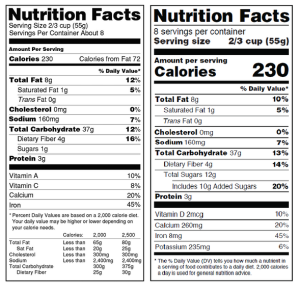 In May, the FDA finalized the new nutrition facts label, which is based on and reflects new scientific information, new nutrition and public health research, more recent dietary recommendations from expert groups and input from the public. This revision should make it easier for consumers to make better informed decisions on their food choices. The basic look of the label will remain the same, but the font size will increase for calories, servings per container and the serving size. Serving size and the number of calories will also be bolder as well in order to emphasize this information. An explanation of the percent Daily Value in the footnote of the label has been simplified to better explain what it means. Additionally, the serving size information was updated to reflect more realistic serving sizes. The serving size information was last updated in 1993 and what was considered a single serving has changed since that time.
In May, the FDA finalized the new nutrition facts label, which is based on and reflects new scientific information, new nutrition and public health research, more recent dietary recommendations from expert groups and input from the public. This revision should make it easier for consumers to make better informed decisions on their food choices. The basic look of the label will remain the same, but the font size will increase for calories, servings per container and the serving size. Serving size and the number of calories will also be bolder as well in order to emphasize this information. An explanation of the percent Daily Value in the footnote of the label has been simplified to better explain what it means. Additionally, the serving size information was updated to reflect more realistic serving sizes. The serving size information was last updated in 1993 and what was considered a single serving has changed since that time.
Manufacturers must reveal the actual amount of vitamin D, calcium, potassium and iron in addition to the percent Daily Value on the label. Vitamin C and A are not required to be listed on the label, but can be included on a voluntary basis. The calories from fat has been eliminated because research has shown that the type of fat is more important than the actual amount of fat. The daily values for nutrients like dietary fiber, sodium and vitamin D were updated because of newer scientific evidence.
Another important change is added sugars in grams, and a percent Daily Value must now be declared on the label. It is recognized by the FDA that added sugars can be part of a healthy diet, but it is difficult to meet nutrient needs if one consumes more than 10 percent of their total daily calories from added sugars while staying within their calorie requirements. The addition of added sugars to the label is intended to increase consumer awareness of the quantity of added sugars in foods, so users may make informed choices based on their individual needs or preferences.
Manufacturers have until July 26, 2018 to meet the necessary requirements. Manufacturers with less than $10 million in annual food sales will be provided an additional year to make the required changes. Any foods imported to the US will need to comply with these required changes as well.

